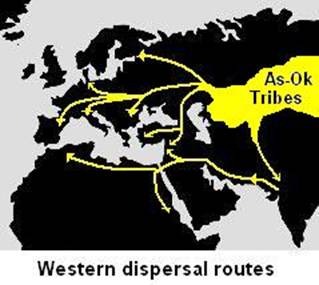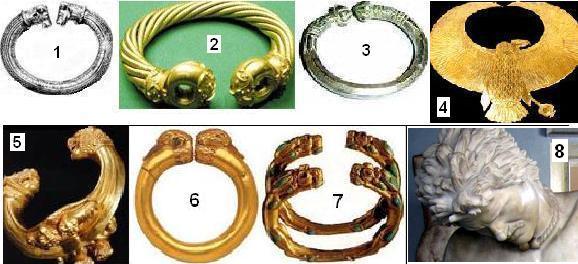|
On May 1891, peat cutters found a silver cauldron near the
hamlet of Gundestrup-Northern Denmark. The cauldron is
presently exhibited in the National Museum of Copenhagen
(1).
There are two scenes on the cauldron which are of special
interest to the subject discussed in the previous chapter,
The bird symbolism. One of them is the second picture from
the left (below) in which a man is holding a torque (torc) in
his right hand and a snake in his left. A stag is standing on
his right side, a lion and a wild boar on his left. He is
sitting cross-legged and is wearing a torc around his neck,
stag antlers on his head. All these small but important
details are pointing to the Asiatic Scythian (Saka) culture
(see Chapter 4, The Asiatic Scythians).
There is a clear similarity between the Indus Valley seal
shown on the right picture and the man of the Gundestrup
cauldron. Both are sitting cross-legged and both wear horns.
The horn symbolism is typical for Central Asiatic ancient
cultures and was transported to the west and to the south by
the As and Ok tribes (see map below).

The
symbolism of the Gundestrup cauldron divulges another hidden
superstition of these ancient people. This is the belief that
the right side represents “the good and the positive” and the
left side represents “the evil and the negative”. We reach to
such a conclusion by noticing the position of the stag and the
torc being on his right side and the snake, the boar and the
lion being on his left side. Therefore, the torc was a
positive binding symbol.

The woman on the third picture from the left is also wearing a
torc. She is holding a bird in her right hand and there are
birds on each side of her head, reminding the bird symbolism
mentioned in the previous chapter. The stag, the horns and the
birds are symbols used extensively by the Asiatic shaman
cultures. The torc held in the right hand of the man on the
Gundestrup cauldron must have a rather special and important
meaning. Although we can not tell for sure, we can guess that
it represents a connection to the loose federation of the
Asiatic Tur-Oc tribes (see previous chapter 29). A collar has
always been and still is an object symbolizing ownership.
Below, we see some interesting objects such as collars,
torques, pectorals and bracelets from different parts of the
world, pointing to a common but forgotten shamanic culture.

1.
Silver torc from Trichtingen South Germany.
2.
Torc from Norfolk – England, mid first century BC.
3.
A Celtic torc. The name “Celt” or “Kelt”, is transformed from
“Kalat / Galat”. This name belonged to an ancient tribe
residing in
Galatia
(Kalat-öyü), a region in Central Anatolia. “Kalat” is formed
from the root kal, meaning “stay” in Turkish.
Therefore, the Kalat were people who came to Central
Anatolia and decided to stay. Present Istanbul has still a
ward named Galata. The Galatians migrated towards the west and
found themselves speaking the same language with the
north-western tribes of Europe
(2)
We find a similar comment in ref.
(1), strengthening the above
claim:
Ferdinand Drexel of the University of Frankfurt argued in 1915
that the cauldron had originated in southeast Europe, the
nearest source of the requisite silverwork skills. This
technological constraint was the mainstay of Drexel’s
contention that the cauldron was Thracian in origin.
Thracia, by the way, is a name transformed from
Tur-Oc-öyü
=> Turoc-ya => Thrakia and finally Thracia. The Turkish name
of this region is still Trakya.
4.
A vulture pectoral found on the head of a mummy and wrongly
interpreted as a crown
(3). It is a rare example of the
“collar of the vulture” known from the coffin pictures of the
Middle Kingdom (1565 BC to 1310 BC). The bird symbolism had an
important place in the belief system of ancient Egypt
representing the soul flying towards the realm of the sun-god
(see Chapter 26, The African Expansion). Gold, with its
yellow color has been the preferred material of sun-worshiping
cultures.
5.
Gold bracelet from western-Iran dated 8th century
BC.
6.
Gold bracelet from western Black Sea region (present
Bulgaria).
7.
A pair of antelope bracelets with turquoise ears and hoofs
from Altyn Tepe
(4).
8.
The statue commissioned by Attalos around 230 BC to celebrate
his victory over the Kalat (Celtic Galatians) of Anatolia. The
statue is known as the “dying Gaul” with a mustache and a torc
around his neck (5), indicating that the Kalats (Galatians),
the Kelts (Celts) and the Kol (Gaul,
(6)) were all of Asiatic
(Uighur) origin and were speaking approximately the same
language.
|